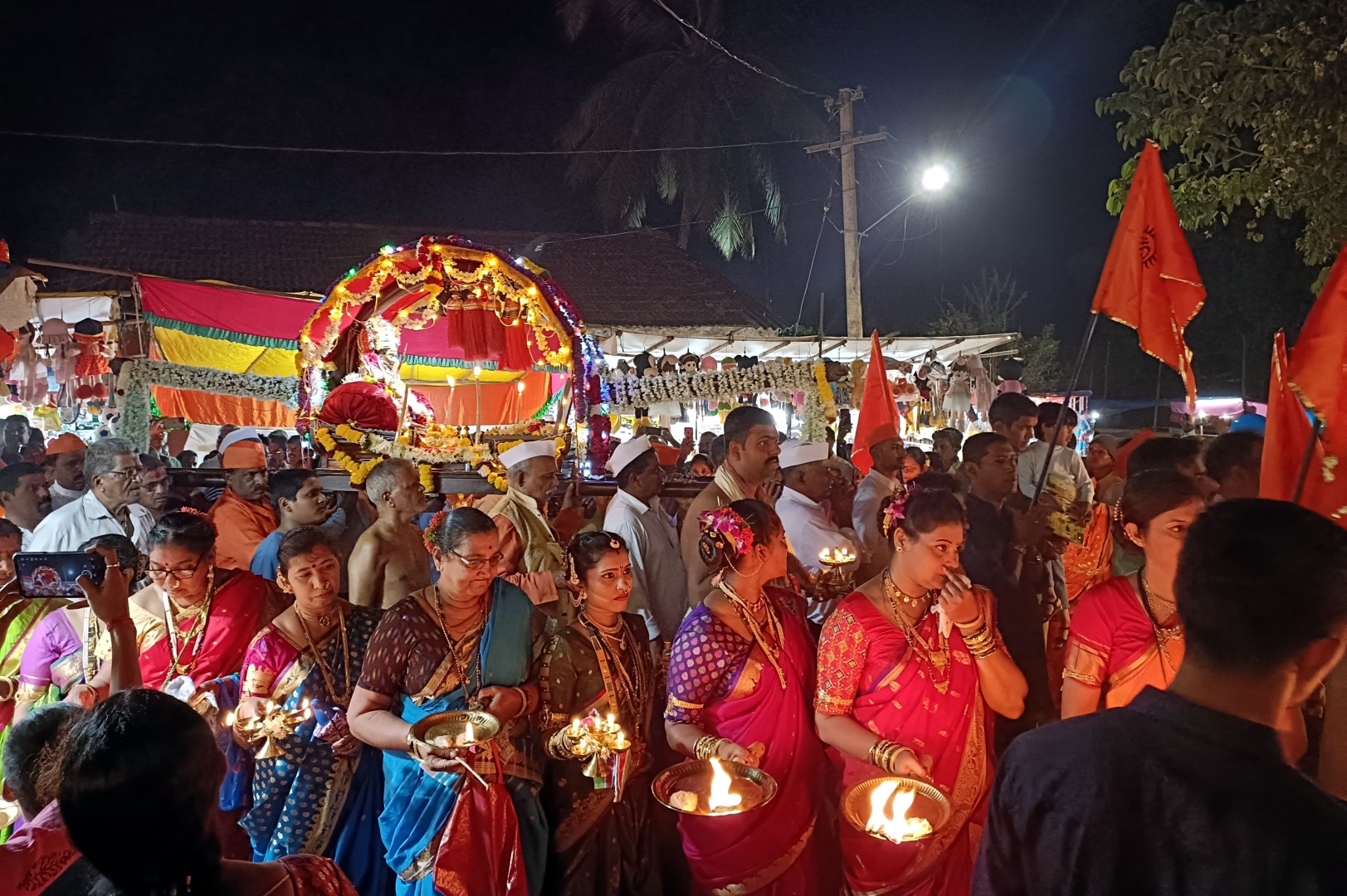
Savashins carry lit-up jodio during the jodio-divaj ceremony at the Sateri Devi temple in Siolim.
All devotees gather again at the Sateri temple premises in Siolim to participate in the Pavni ceremony (public auction) at about 7 pm. This is followed by the Jodio and Divaja ceremony celebrated by the Savashins. In the Pavni held in the Mandap (main hall), all items received during the week-long Palkhi Utsav are auctioned off. Although this Pavni is attended by male and female devotees, only the male Hindu devotees can bid for the items auctioned off. The proceeds earned from this Pavni (auction) are used towards the future welfare expenditure of the temple by the committee members.
PROCESSION OF JODIO, DIVAJA
The Sateri temple celebrates the ceremonious grand procession of Jodio and Divaja to commemorate the Vadd Diwas at about 7.30 pm or 8 pm. This procession is attended by several devotees and Savashins (Hindu married women). The Savashins residing in the Vaatar of Siolim, Sodiem, and Oxel and families who worship goddess Sateri as their Gramdevta, participate in the procession to perform the ritual of Jodio. They dress in the traditional costume of a Kapodd (nine-yard handloom saree of cotton or silk), wearing a lot of gold jewellery, and adorning their hair with flowers.
They carry a copper or brass plate filled with Jodio (365 pairs of cotton wicks) soaked in oil. Here, each pair of cotton wicks symbolises one day in the life of a couple and 365 Jodios symbolise one year in their life. Each Savashin (woman) carrying this plate of lighted-up Jodio during the procession prays for good health for her husband during the forthcoming year.
The Savashins living in Siolim Vaatar or elsewhere in Goa, but belonging to families that worship goddess Sateri of Siolim as their Kuldevta (family god) also participate in this grand procession to perform the ritual of Divaja. They too dress in the traditional costume same as the other Savashins but carry a Divaj (multi-layered traditional brass lamp) with lighted-up cotton wicks dipped in oil instead of the plate of Jodio.
During the Jodio and Divaja ceremony, the goddess Sateri is taken in her Palkhi for a Pradakshina/Parikrama (circumambulation in a clockwise direction) around the temple premises. This procession is taken out to the tune of the beating of drums and other traditional musical instruments. It is accompanied by the Bhatt (temple priest), elders from the Vaatar of the worshippers of goddess Sateri and the Savashins with the lighted-up Jodio and Divaj.
After completing a single Pradakshina, the Palkhi is taken inside the temple, while the Savashins continue with another four Pradakshinas (rounds) to complete five rounds. Later on, before midnight, the Jodio and Divaja ceremony of the Sateri Vadd Diwas ends, and all the devotees return to their homes.
The next morning, the Palkhi (wooden palanquin) is dismantled and kept inside the store room of the temple while the idol of goddess Sateri is kept in a special niche. The Palkhi is kept in storage only to be removed again for celebrating the Palkhi Utsav and the Sateri Vadd Diwas next year.
The Palyekar family of Danddo vaddo in Siolim has been worshipping goddess Sateri as their Gramdevta for generations. Hence, my friend Supriya Palyekar who has been married to Santosh Palyekar in this family for the last twenty-three years has been participating in the Palkhi Utsav and Vadd Diwas of the goddess every year.
Like her, other devotees and Savashins from the villages Siolim, Sodiem, and Oxel have been carrying on with this tradition every year without fail. Supriya says that devotees from the neighbouring places of Pednem, Bardez, and Bicholim also come in large numbers to participate in the ceremony of Sateri Vadd Diwas every year. (Concluded)
[The writer is an architect by profession and is passionate about festivals and traditions in Goa]